Introduction
Over the years, I’ve made Cacio e Pepe many times, with inconsistent results. I can say the same thing about Pasta Carbonara. Issues ranged between the cheese not melting into a creamy sauce to the cheese becoming a stringy mess that sticks to the pan. The eggs in Carbonara just made things worse with their propensity to form curds instead of transforming to rich creaminess.
That changed when I came across this video by Roman chef Luciano Monosilio. Luciano speaks in Italian, but there are English subtitles. Luciano demonstrates three methods of cooking Cacio e Pepe. First, the traditional method, where the cheese is “simply” combined with pepper, hot pasta and starchy pasta water. Of course, he’s successful. As he is cooking, he explains the need to be precise with temperature control. It must get hot enough to melt the cheese and cream the sauce, but not hotter than 70°C (158°F) where the cheese will become stringy. The second method is the foolproof (“infallibile”, pronounced in·fal·lì·bi·le) method. He actually uses this method in his restaurant where he needs it to work every time. The infallibile method uses a secret ingredient, a gel of cornstarch and water. The cornstarch acts as an emulsifier allowing the cheese and the pasta water to form a creamy sauce under higher heat without the cheese separating into a stringy mess. The third method demonstrated is a gourmet version of the dish.
As you might guess, it was the foolproof (infallibile) method that changed my game. My first attempt at Cacio e Pepe with a cornstarch gel was a complete success. Then I remembered reading about using a cornstarch slurry to make creamier scrambled eggs, so I thought the same idea might work for Pasta Carbonara. I tried it, and, again, immediate success on a dish for which I was historically inconsistent. For the past few months I’ve been making Cacio e Pepe or Carbonara about once per week, experimenting with different variables. I’ve tried different cheeses, including soft melty cheeses. I’ve finely grated and roughly grated the cheeses. I’ve tried using raw cornstarch slurries to save the 30 seconds in the microwave to create the gel. I’ve tried loosely combining the ingredients in bowl with a spoon and I’ve tried pureeing all the ingredients with a blender. Amongst all these experiments, none were failures. Infallibile! Still, while none were failures, some were more successful. Now, I’m done with experimentation and have settled on the techniques which achieved optimal results with relative ease.
The Cheese
I think it’s safe to say that Pecorino Romano is the traditional cheese of choice for Cacio e Pepe. Many purists would say that it is the only choice. Others prefer to use Parmigiano Reggiano. Marcella Hazan doesn’t have a recipe for Cacio e Pepe in her classic Essentials of Classic Italian Cooking. Instead she offers Butter and Parmesan Cheese Sauce prepared in the same fashion as Cacio e Pepe. Some recipes call for a mix of Pecorino Romano and Parmigiano Reggiano. Luciano suggests a blend of Pecorino Romano and Grana Padano. Among my experiments. I tried using a softer, meltier cheese. As the method is infallibile, I did get a nice creamy sauce with the softer, meltier cheese, but it lacked the flavor punch that aged grating cheeses bring to the dish. Stick with aged grating cheeses! I’m a fan of using Calvander, a cheese made in the style of aged Asiago by Chapel Hill Creamery. Using ingredients that are local to you is more Italian than importing ingredients from other continents!
The Cornstarch
Luciano’s video proposes making a gel with cornstarch and water. I found that I could do this easily in the microwave. I measure 50 milliliters of water (about 3.5 tablespoons) and 5 grams of cornstarch (about 2 teaspoons) and whisk it into a slurry. That goes into the microwave set for 30 seconds. At 15 or 20 seconds, I pull it out and give it a quick whisk. It goes back into the microwave to finish the 30 seconds of cooking. When it comes out it gets one final whisk into a homogenous gel.
My main use for cornstarch in the kitchen has been to thicken the sauce in stir fries. This is done by pouring a raw cornstarch slurry into the hot sauce and continuing a bit longer with the heat. The cornstarch nicely thickens the sauce. Similarly, the creamier scrambled eggs method uses a raw cornstarch slurry. I experimented to see if I could save 30 seconds by using a raw slurry instead of cooking up a cornstarch gel. The answer was yes and no. Using a raw cornstarch slurry did indeed work, but it didn’t save 30 seconds. Using the raw slurry added more than 30 seconds to the cook time of the final sauce. Also, the final sauce seemed just a little bit less smooth than I get with the pre-cooked gel. So, stick with the gel.
Blend It
Luciano’s video proposes using a stand blender to combine the cheese, pepper, cornstarch gel and olive oil, to form a thick goo. Cooking this goo with the hot pasta and a splash of pasta water transforms it to the expected creamy sauce. Using a stand blender to prepare for dozens of servings in a restaurant environment makes sense, but it’s not worth the mess to prepare a single batch at home. Fortunately, using an immersion blender is an easy-to-clean-up compromise that works just fine. In my first attempt, I used an immersion blender, and included the pasta water in the mix. As noted above, my first attempt was a complete success.
Among my experiments, I tried to skip the blending process a few times. I just mixed things up with a rubber spatula. Note that the blender completely pulverizes the cheese, so you end up with a homogenous sauce which just needs some cooking. If you just stir up the ingredients, the grated cheese will require time to melt before you can get a homogenous sauce. How much time depends on how finely the cheese is grated. Any time saved by rough grating vs. fine grating is lost in the cooking time. Similarly, any time saved by not blending is also lost in the cooking time. I also found that extended cooking times somehow makes the final result a little bit less smooth and creamy. So, I decided that a rough grate of the cheese and a quick blend with an immersion blender optimizes the effort vs. the results.
The Pasta Water
Traditionally, Cacio e Pepe depended on the starch in the pasta water to act as the emulsifier and thickener of the pasta sauce. While the cornstarch gel supplants the need for starchy pasta water, using starchy pasta water certainly helps. Also, the pasta water should be well seasoned. You want it to be salted like soup. If you follow the adage of pasta water needing to “taste like the sea,” finishing with that pasta water will over-salt pasta dish. If you aren’t using fresh pasta, and are OK with short pasta shapes, I like to use this method to cook the pasta.
Don’t Forget Your Veggies
Often, when the main dish in a meal lacks any vegetables, my first thought is to serve with a salad. That can certainly work here. But, Cacio e Pepe oozes guilty pleasure comfort food vibes. The side salad doesn’t quite fit the theme. But, there are options that are totally in line with the comfort food feeling. My favorite is roasted winter squash. Go with between 12 ounces and a pound. Add a couple ounces to the cheese mixture and stir the rest in with the pasta. Tender greens such as spinach, chard or baby kale are great options. Six to eight ounces works well. Blanch them a bit in the pasta water and stir them in to the dish towards the end. A third idea is to make roasted cauliflower as a side to the Cacio e Pepe.
Photo Walk Through of Recipe
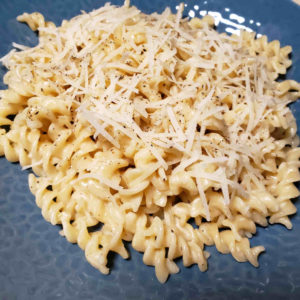
Infallibile Cacio e Pepe
Ingredients
- 50 grams water a generous 3 tbsp
- 5 grams cornstarch about 2 tsp
- 4 oz grated Pecorino Romano see notes
- 3 tbsp olive oil
- freshly ground black pepper
- 1 lb dry pasta
- salt
- 4 oz reserved pasta cooking water
Instructions
Prepare the cornstarch gel
- Place the 50 grams of water and 5 grams of cornstarch in a microwavable bowl and whisk into a slurry.
- Place in the microwave for 15 seconds. The corn starch should have started to thicken, but also has drifted toward the bottom of the bowl. Re-whisk the solution.
- Return to the microwave for another 15 seconds and re-whisk. At this point the gel should be stable. If not one more round in the microwave and one more whisk should do it.
- Allow the cornstarch gel to cool
Prepare the sauce ingredients
- Select a container that works well with an immersion blender. Most immersion blenders come with a mixing cup, and wide mouthed mason jars generally work well.
- Add the grated cheese, cooled cornstarch gel, and olive oil to the container. Also add a generous amount of freshly ground black pepper, to taste.
Prepare the Pasta
- Prepare the pasta according to package directions. Alternately use the directions available at https://thought4food.life/kenjis-new-way-to-cook-pasta/. The pasta water should be well seasoned with salt. Think salted like soup (delicious), not salted like the ocean (not delicious).
- Reserve a cup of the pasta cooking water at the end of the cooking process.
Blend the Sauce and Finish the Pasta
- Add four ounces of the pasta cooking water to sauce ingredients and use an immersion blender to puree everything into a homogenous sauce.
- Add the still hot, drained pasta and the pureed sauce to a pot and stir with a silicon spatula over medium-low heat. Continue heating and stiring until the sauce has obtained the desired creamy texture and clings nicely to the pasta.
- Plate the pasta and garnish with additional grated cheese and freshly ground black pepper.
Notes
- Pecorino Romano is the traditional cheese for Cacio e Pepe. But some people prefer Parmigiano Reggiano or a blend of the two cheeses. Other flavorful, aged grating cheeses will also work. The choice is really up to you.
- 4 ounces of hard grating cheese, by weight, is about 1 1/3 cup in volume.

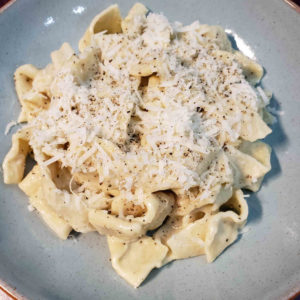
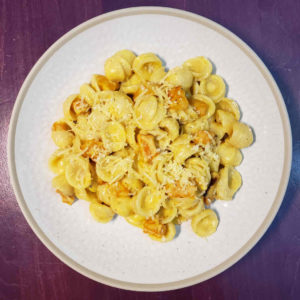
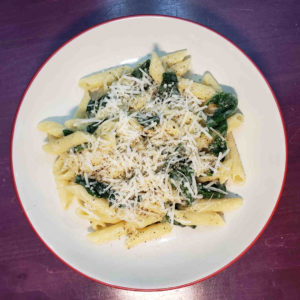
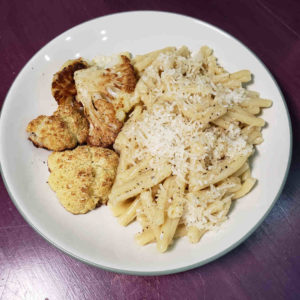
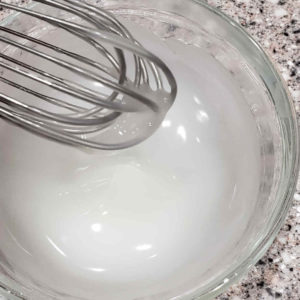
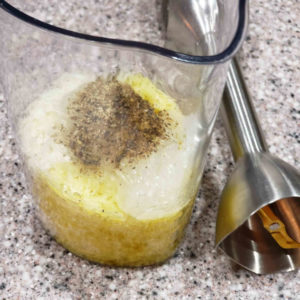
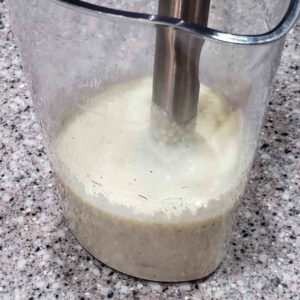

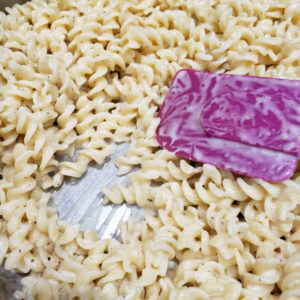
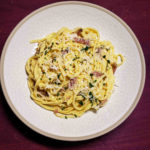
One Response
Terrific explanation! Terrific instructions! Exquisite results! Thank you!